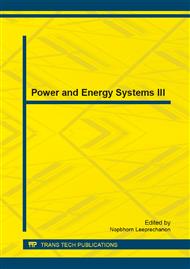[1]
D. Mc Collum, C Yang, Achieving deep reductions in US transport greenhouse gas emissions: Scenario analysis and policy implications, Energy Policy 37 (2009), p.5580–5596.
DOI: 10.1016/j.enpol.2009.08.038
Google Scholar
[2]
X. Ou, X. Zhang, S. Chang, Alternative fuel buses currently in use in China: Life-cycle fossil energy use, GHG emissions and policy recommendations, Energy Policy 38 (2010), p.406–418.
DOI: 10.1016/j.enpol.2009.09.031
Google Scholar
[3]
K.C. Bayindir, M. A. Gozukucuk, A. Tekel, A comprehensive overview of hybrid electric vehicle: Power train configurations, power train control techniques and electronic control units, Energy Conversion and Management 52 (2011), p.1305–1313.
DOI: 10.1016/j.enconman.2010.09.028
Google Scholar
[4]
C. Guille, G. Gross, A conceptual framework for the vehicle-to-grid (V2G) implementation, Energy Policy 37 (2009), p.4379–4390.
DOI: 10.1016/j.enpol.2009.05.053
Google Scholar
[5]
G.J. Offer, D. Howey, M. Contestabile, R. Clague, N.P. Brandon, Comparative analysis of battery electric, hydrogen fuel cell and hybrid vehicles in a future sustainable road transport system, Energy Policy 38 (2010), p.24–29.
DOI: 10.1016/j.enpol.2009.08.040
Google Scholar
[6]
C.E. Thomas, Fuel cell and battery electric vehicles compared, International Journal of Hydrogen Energy (2009), p.6005 – 6020.
DOI: 10.1016/j.ijhydene.2009.06.003
Google Scholar
[7]
W. Kempton, T. Kubo, Electric-drive vehicles for peak power in Japan, Energy Policy 28 (2000), pp.9-18.
DOI: 10.1016/s0301-4215(99)00078-6
Google Scholar
[8]
D. Yamashita, T. Niimura, H. Takamori, H. Takamori, A Dynamic Model of Plug-in Electric Vehicle Markets and Charging Infrastructure for the Evaluation of Effects of Policy Initiatives, Power Systems Conference and Exposition (PSCE), IEEE/PES (March 2011), pp.1-8.
DOI: 10.1109/psce.2011.5772534
Google Scholar
[9]
M. Duke, D. Andrews, T. Anderson, The feasibility of long range battery electric cars in New Zealand, Energy Policy 37 (2009), p.3455–3462.
DOI: 10.1016/j.enpol.2008.10.047
Google Scholar
[10]
Y. Ma, T. Houghton, A. Cruden, D. Infield, Modeling the Benefits of Vehicle-to-Grid Technology to a Power System, IEEE Transactions on Power Systems 27(2) (2012), pp.1012-1020.
DOI: 10.1109/tpwrs.2011.2178043
Google Scholar
[11]
J. Dong, Z. Lin, Within-day recharge of plug-in hybrid electric vehicles: Energy impact of public charging infrastructure, Transportation Research Part D 17 ( 2012), p.405–412.
DOI: 10.1016/j.trd.2012.04.003
Google Scholar
[12]
P. Zhang, K. Qian, C. Zhou, B. G. Stewart, D. M. Hepburn, A Methodology for Optimization of Power Systems Demand Due to Electric Vehicle Charging Load, IEEE Transactions on Power Systems 27 (3) (2012), pp.1628-1636.
DOI: 10.1109/tpwrs.2012.2186595
Google Scholar
[13]
P. Richardson, D. Flynn, A. Keane, Local Versus Centralized Charging Strategies for Electric Vehicles in Low Voltage Distribution Systems, IEEE Transactions on Smart Grid 3(2) (2012), pp.1020-1028.
DOI: 10.1109/tsg.2012.2185523
Google Scholar
[14]
R.T. Doucette, M.D. McCulloch, Modeling the CO2 emissions from battery electric vehicles given the power generation mixes of different countries, Energy Policy 39 (2) (2011), p.803–811.
DOI: 10.1016/j.enpol.2010.10.054
Google Scholar
[15]
International Electrotechnical Commission (IEC) standarts of electrical connectors and charging modes for electric vehicles, IEC 62196 http: /en. wikipedia. org/wiki/IEC_62196 (Accessed, august 2013).
Google Scholar


